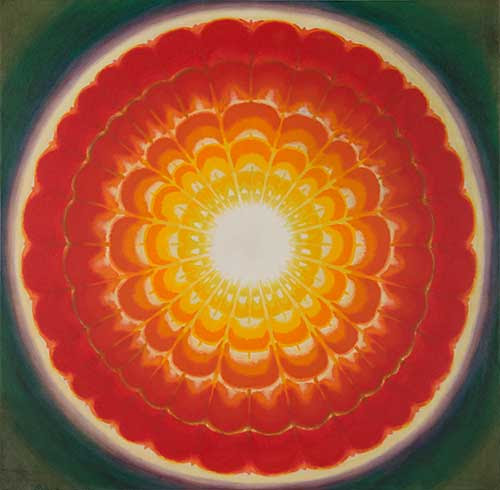Contribute
| Figuring The Abstract In Indian Art |
Press Release
07/15/2014
The Peabody Essex Museum (PEM) is pleased to present Figuring the Abstract in Indian Art,
an installation of late 20th-century modernist paintings and
19th-century devotional Hindu sculptures. Moving across time, form and
function, this installation explores the concepts of figuration and
abstraction in the context of Indian art. The 20 works on view are drawn
from PEM's Chester and Davida Herwitz Collection -- the most important
holding of 20th-century modern Indian art in the U.S. -- the Leo Figiel
Collection of vernacular metal sculpture and the Tina and Anil Ambani
Collection -- one of India's leading private collections. Figuring the Abstract in Indian Art is on view through mid-2015. “This
installation uses traditional devotional images of Hindu gods and
goddesses as a way to unlock concepts of the abstract in Indian
traditional and modern art,†says Sona Datta, PEM’s curator of Indian
and South Asian Art. “By looking at bronzes figures, such as Shiva or
the mighty warrior Durga, we understand that Hinduism provides a vehicle
for ordinary mortals to access the divine and the universal. This idea
is approached alternately in modern art through painters such as Biren
De, who express the essential notion of the divine through pure
abstraction.†In
the middle of the last century, modernism provided a new framework in
which Indian artists could express abstract concepts through
non-representational forms by using color, flatness and space. The
tumbling human forms of Tyeb Mehta effectively use fragmentation as a
means of expressing the very human pain of political divide.
Concurrently, M.F. Husain’s 1950 painting Man
provoked a collector in New York to ask why the artist didn’t paint
like an abstract expressionist. Husain replied, “There is nothing
abstract about a billion people.†This installation celebrates India’s
modern artists who were able to effectively look towards the language of
international modernism while remaining firmly rooted in the distinct
context of India. IMAGE CREDIT: Biren De, 1926 – 2011. You-July '70,
1970. Oil on canvas; 51 x 52 inches (129.5 x 132 cm); The Chester and
Davida Herwitz Collection, Peabody Essex Museum, Salem, Massachusetts,
E301118 ABOUT THE PEABODY ESSEX MUSEUM The
Peabody Essex Museum (PEM) is one of the oldest and fastest growing
museums in North America. At its heart is a mission to transform
people’s lives by broadening their perspectives, attitudes and knowledge
of themselves and the wider world. PEM celebrates outstanding artistic
and cultural creativity through exhibitions, programming and special
events that emphasize cross-cultural connections and the vital
importance of creative expression. Founded in 1799, the museum’s
collection is among the finest of its kind boasting superlative works
from around the globe and across time –– including American art and
architecture, Asian export art, photography, maritime art and history,
as well as Native American, Oceanic and African art. PEM’s campus
affords a varied and unique visitor experience with hands-on creativity
zones, interactive opportunities, performance spaces and historic
properties, including Yin Yu Tang: A Chinese House, a 200â€yearâ€old house
that is the only example of Chinese domestic architecture on display in
the United States. HOURS: Open Tuesday-Sunday, 10 am–5 pm and the third Thursday of every month until 9 pm. Closed Mondays (except holidays), Thanksgiving, Christmas and New Year's Day. ADMISSION:
Adults $18; seniors $15; students $10. Additional admission to Yin Yu
Tang: $5. Members, youth 17 and under and residents of Salem enjoy free
general admission and free admission to Yin Yu Tang. INFO: Call 866â€745â€1876 or visit our Web site at www.pem.org MEDIA CONTACTS: Whitney Van Dyke | Manager of Public Relations | whitney_vandyke@pem.org | 978-542-1828 Dinah Cardin | Press Officer / Special Projects Writer | dinah_cardin@pem.org | 978-542-1830
You may also access this article through our web-site http://www.lokvani.com/

On view through mid-2015